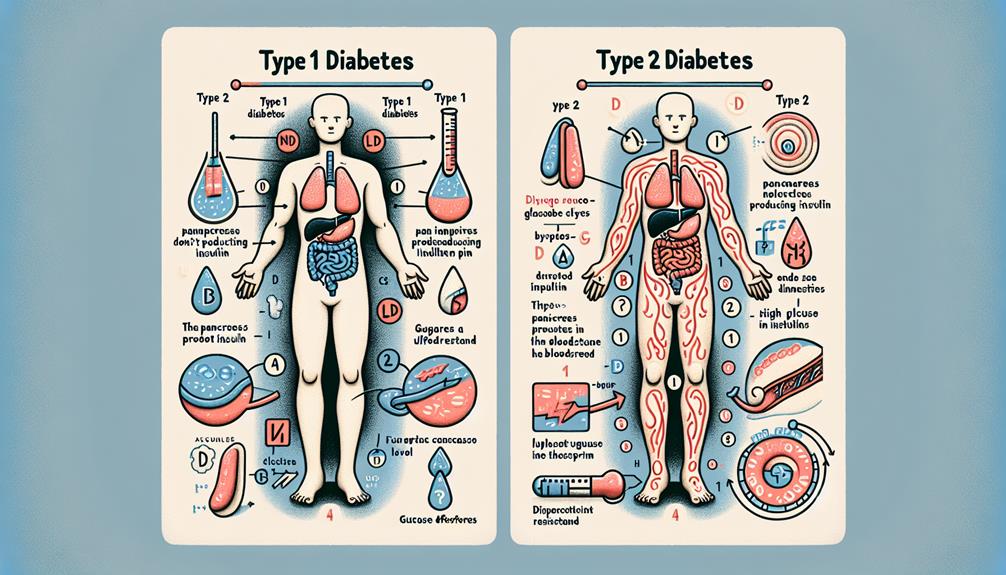
Discover the varied world of diabetes, from familiar Type 1 and Type 2 to rare types like Alström Syndrome. Type 1 is immune-mediated, while Type 2 involves insulin resistance. Gestational Diabetes can affect pregnancy. LADA mimics Type 1 in adults, requiring specific testing. MODY is genetic, often diagnosed young. Neonatal Diabetes appears early due to genetic mutations. Syndromes like Wolfram combine diabetes with other conditions. Alström Syndrome involves multiple organ systems. Each type requires tailored management strategies for optimal health. Unravel the complexities of diabetes beyond the common types for a deeper understanding.
Types of Diabetes Key Takeaways
- Type 1 Diabetes is caused by the immune system attacking beta cells, leading to insulin deficiency.
- Type 2 Diabetes involves insulin resistance or inadequate insulin production, affecting blood sugar processing.
- Gestational Diabetes occurs during pregnancy and requires careful blood sugar management.
- LADA is often misdiagnosed as type 2 diabetes but shares autoimmune features with type 1.
- MODY is a rare form of diabetes with onset before age 25, linked to genetic mutations affecting beta cells.
Type 1 Diabetes
Type 1 diabetes is a chronic condition where the immune system attacks and destroys the insulin-producing beta cells in the pancreas. This autoimmune response leads to a lack of insulin, the hormone responsible for regulating blood sugar levels. Without enough insulin, glucose accumulates in the bloodstream, causing high blood sugar levels known as hyperglycemia.
Individuals with Type 1 diabetes often experience symptoms such as excessive thirst, frequent urination, unexplained weight loss, fatigue, and blurred vision. These symptoms can develop rapidly, sometimes over a few weeks. It's crucial for individuals with Type 1 diabetes to manage their condition diligently through a combination of insulin therapy, blood sugar monitoring, and a balanced diet.
Since Type 1 diabetes isn't preventable and has no cure, lifelong treatment is necessary. It's essential for those with this condition to work closely with healthcare providers to optimize their treatment plan and maintain stable blood sugar levels to prevent complications such as cardiovascular disease, kidney damage, and nerve damage.
Type 2 Diabetes
Characterized by insulin resistance or insufficient insulin production, Type 2 Diabetes is a metabolic disorder that affects how your body processes blood sugar. Insulin resistance occurs when your body's cells don't respond effectively to insulin, leading to elevated blood sugar levels. This type of diabetes is commonly diagnosed in adults but can also affect children and adolescents. Risk factors for Type 2 Diabetes include obesity, physical inactivity, genetics, and age.
Managing Type 2 Diabetes involves lifestyle modifications such as maintaining a healthy diet, regular exercise, monitoring blood sugar levels, and taking medications if prescribed by your healthcare provider. It's crucial to control blood sugar levels to prevent complications such as heart disease, nerve damage, kidney problems, and vision loss.

Regular medical check-ups, including blood tests to monitor glucose levels and assess overall health, are essential for effectively managing Type 2 Diabetes. By following a comprehensive treatment plan and making healthy choices, you can effectively manage this condition and reduce the risk of long-term complications.
Gestational Diabetes
Gestational Diabetes, occurring during pregnancy, poses unique challenges in managing blood sugar levels to ensure both maternal and fetal health. This type of diabetes develops when the body cannot produce enough insulin to meet the extra needs in pregnancy. It can lead to complications for both the mother and the baby if not carefully monitored and controlled.
| Challenges | Impact |
|---|---|
| Blood sugar control | Risk of macrosomia (large birth weight) |
| Diet management | Potential for neonatal hypoglycemia |
| Monitoring | Higher likelihood of cesarean delivery |
Proper management of gestational diabetes involves close monitoring of blood sugar levels, following a tailored diet plan, and possibly insulin therapy. If left uncontrolled, it can increase the risk of complications during pregnancy and delivery. Regular prenatal check-ups and working closely with healthcare providers are crucial in ensuring the well-being of both the mother and the baby.
Latent Autoimmune Diabetes in Adults (LADA)
During pregnancy, you discussed the challenges of managing blood sugar levels in gestational diabetes; now, turning to Latent Autoimmune Diabetes in Adults (LADA), this form of diabetes presents unique diagnostic and treatment considerations in adults.
LADA is often misdiagnosed as type 2 diabetes due to its onset in adulthood and slow progression, but it shares autoimmune features with type 1 diabetes. In LADA, the immune system attacks beta cells in the pancreas, leading to insulin deficiency over time. Unlike type 2 diabetes, individuals with LADA are prone to developing insulin dependency relatively soon after diagnosis.
Diagnosing LADA involves testing for specific autoantibodies like GAD and IA-2, which are typically present in autoimmune diabetes. Treatment for LADA usually includes early initiation of insulin therapy to preserve remaining beta cell function and maintain optimal blood sugar control. Additionally, lifestyle modifications, such as a healthy diet and regular exercise, play a crucial role in managing LADA.

Understanding the distinctions between LADA and other forms of diabetes is essential for healthcare providers to provide appropriate care and support for individuals with this unique condition.
Maturity-Onset Diabetes of the Young (MODY)
Maturity-Onset Diabetes of the Young (MODY) is a rare form of diabetes characterized by genetic mutations affecting beta cell function and insulin production. Unlike type 1 or type 2 diabetes, MODY typically appears before the age of 25 and is often misdiagnosed as type 1 or type 2 diabetes due to its atypical presentation. Genetic testing is crucial for an accurate diagnosis of MODY, as identifying the specific gene mutation can guide treatment decisions and help predict the progression of the disease within families.
Individuals with MODY often have a strong family history of diabetes, with inheritance patterns differing based on the specific gene involved. There are several subtypes of MODY, each caused by mutations in different genes responsible for regulating insulin secretion. Treatment for MODY varies depending on the genetic subtype but may involve oral medications, diet modifications, and in some cases, insulin therapy.
Early detection of MODY is essential to prevent complications and ensure appropriate management, highlighting the importance of genetic testing in individuals with suspected monogenic diabetes.
Neonatal Diabetes
Neonatal Diabetes, a rare form of diabetes, presents in the first six months of life and is characterized by impaired insulin production in newborns. Unlike Type 1 or Type 2 diabetes, neonatal diabetes is caused by genetic mutations that affect insulin secretion, leading to high blood sugar levels. The symptoms of neonatal diabetes can include excessive thirst, frequent urination, dehydration, and failure to thrive. It's crucial to diagnose neonatal diabetes promptly to prevent complications such as developmental delays and seizures.
Treatment for neonatal diabetes often involves carefully monitoring blood sugar levels and administering insulin therapy. In some cases, oral medications may be used to manage the condition. Genetic testing is recommended for individuals diagnosed with neonatal diabetes to identify the specific genetic mutation causing the disorder. Understanding the genetic basis of neonatal diabetes is essential for personalized treatment and genetic counseling. Research continues to explore new therapies and interventions to improve outcomes for individuals with this rare form of diabetes.

Wolfram Syndrome
Another one of the types of diabetes is a rare genetic disorder Wolfram Syndrome, also known as DIDMOAD syndrome. This is characterized by a combination of diabetes insipidus, diabetes mellitus, optic atrophy, and deafness. This condition affects multiple systems in the body, leading to a range of symptoms and complications. Here are some key points to understand about Wolfram Syndrome:
- Progressive Nature: Symptoms of Wolfram Syndrome typically appear in childhood and worsen over time, affecting various aspects of the individual's health.
- Genetic Basis: The syndrome is caused by mutations in the WFS1 gene, impacting the functioning of specific proteins within cells.
- Management Challenges: Due to the complex nature of the condition, managing Wolfram Syndrome requires a multidisciplinary approach involving various healthcare professionals.
- Research and Support: Ongoing research is focused on understanding the underlying mechanisms of Wolfram Syndrome and developing potential treatments to improve the quality of life for affected individuals.
Alström Syndrome
Characterized by a constellation of symptoms that impact multiple systems, Alström Syndrome is a rare genetic disorder that presents unique challenges in its management and treatment. Individuals with Alström Syndrome often experience progressive vision and hearing loss, obesity, type 2 diabetes mellitus, and heart and liver issues. The syndrome is caused by mutations in the ALMS1 gene, affecting ciliary function and various cellular processes.
| Symptom | Description | Management |
|---|---|---|
| Vision Loss | Progressive cone-rod dystrophy leading to blindness in early adulthood. | Regular ophthalmologic evaluations and visual aids can help manage vision loss. |
| Hearing Loss | Sensorineural hearing impairment that can worsen over time. | Hearing aids or cochlear implants may be recommended to improve communication. |
| Obesity | Excessive weight gain due to metabolic abnormalities. | Balanced diet, exercise, and possibly medications under medical supervision are essential for weight management. |
Conclusion
You have learned about the various types of diabetes, each with its own unique characteristics and implications.
Despite advances in research and treatment options, managing diabetes can still be a challenging and lifelong journey.
It's ironic how something as common as sugar can have such a profound impact on our health and well-being.
Remember, knowledge is power in the fight against diabetes, so stay informed and be able to recognize the types of diabetes to take control of your health.





